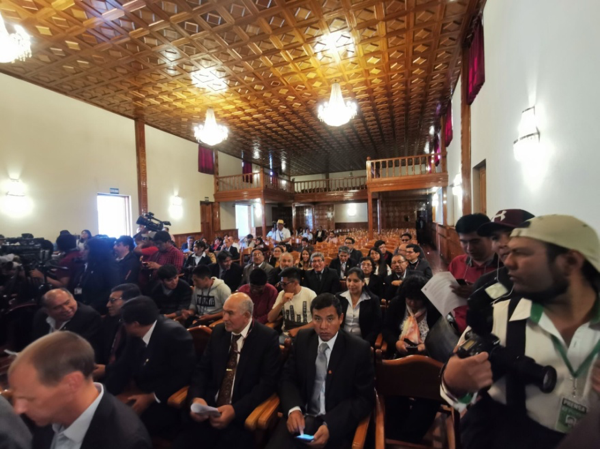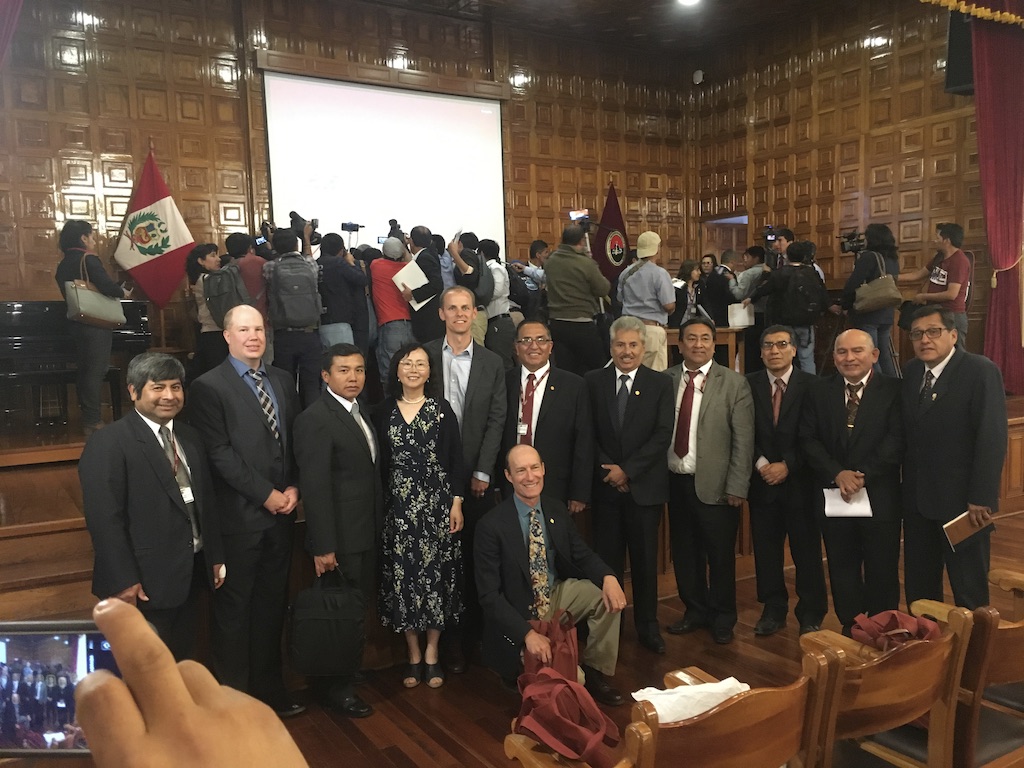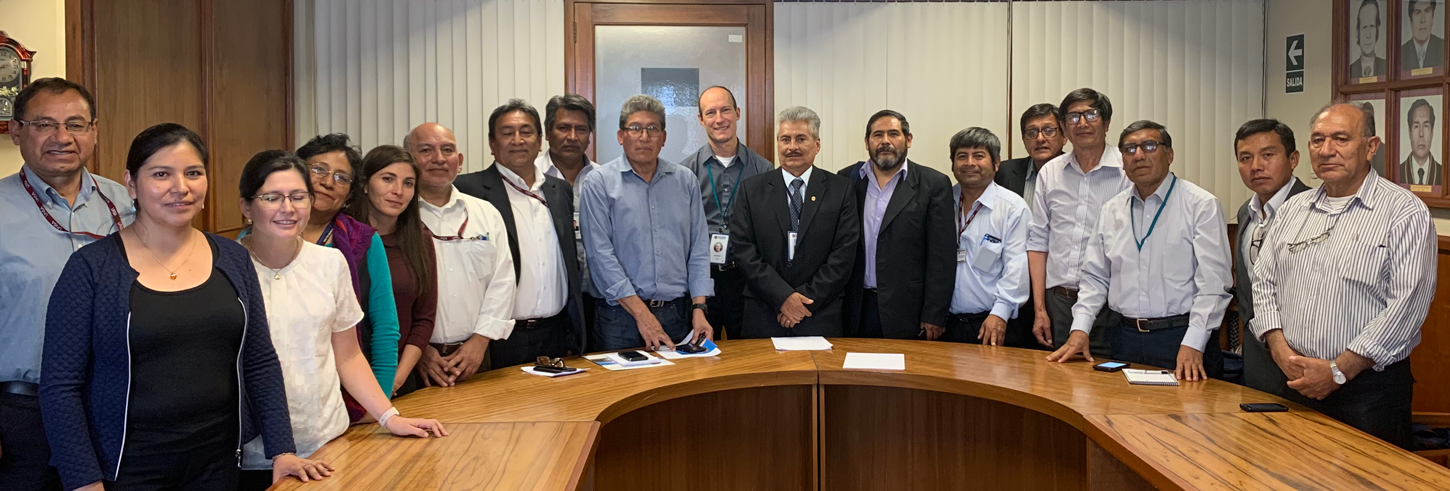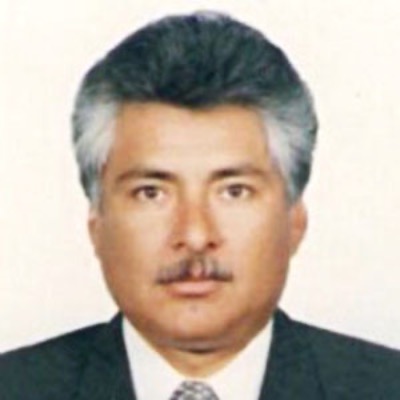News
September, 2022 UNSA and Colorado School of Mines win international award for book on current sediment management
Read details on UNSA’s website in Spanish by clicking here!
January, 2021 Payne commentary series: Resource Conflict in the Energy Transition
By Elsa Barron, Gregory Clough, Alicia Polo y La Borda Cavero, Morgan Bazilian, Henry Gustavo Polanco Cornejo, and Eliseo Zeballos Zeballos
This November at COP26, the United Nations Conference on Climate Change, nations around the world responded to a global call for an energy transition away from fossil fuels and towards renewable forms of energy Many countries released their commitments to reach net-zero greenhouse gas emissions and in response, activists, policymakers, and businesses are working to make the energy transition a reality. However, such large changes in socio-technical systems do not come without consequences.
Energy transitions occurring globally—towards low-carbon technologies, increased electrification, and electric vehicles and battery storage capacity—will also produce significant challenges in resource-rich areas. The demand for a varied set of mineral resources and metals that are required for renewable energy technologies such as solar panels and batteries is set to grow at an unprecedented scale. Many of the countries with the largest potentials for these minerals are in emerging and developing economies that face capacity and governance challenges. In light of the increased pressure that will be placed on these countries, more research, analysis, planning, and innovative business models are required to address governance challenges in developing countries.
Peru is one of the most resource-rich countries in the world and provides an abundance of minerals and metals important to the energy transition. It is the second-largest producer of copper, which is required in the production of cables, rods, and sheets that are used to build solar panels, windmills, and electric cars. It is also the second-largest producer of silver, used for various solar technologies. Peru is also the third-largest producer of Zinc, used in rechargeable batteries, and on wind turbines to prevent metal corrosion. In addition, Peru is a producer of selenium and indium.
The mining industry employs many Peruvians, mobilizing different types of resources, and has spurned growth to the nation’s economy over the past three decades, but that is not the full story. It has also caused negative environmental and social impacts that create opposition at a local and community level against mining projects and operations.
Sixty-five percent of socio-environmental conflicts in Peru are related to mining and several regions face the greatest mining conflict impacts: Apurimac, Ancash, Ayacucho and the rest of the so-called mining corridor in Southern Peru. Recent protest in the Apurimac region highlight the governance challenges faced by mining companies, the State, and communities.
A low-carbon future demands effective and efficient governance for mutual benefit. There is a need to implement thoughtful research and communications on the connection between global energy demand and local community impacts as well as the complexity of conflicts on the ground. The Universidad Nacional de San Agustin de Arequipa (UNSA) and the Payne Institute for Public Policy – a policy research institute at the Colorado School of Mines – have the opportunity to establish a group of professionals and experts to generate and provide the information and analysis necessary to connect the Peruvian mining industry with international energy trends and local economic and environmental needs. Doing so is the first step to understanding and addressing the complex global energy transition that lies ahead in the remainder of the twenty-first century.
By partnering with the world-renowned Payne Institute for Public Policy, the UNSA think tank can connect UNSA’s professional and technical expertise with relevant local experts and stakeholders in order to advance policy making in Arequipa and other regions in Peru and above all to participate in the global discussion around resources and the energy transition. UNSA will be the first university outside of Lima to dedicate a research center to contribute to the proposition of positive extractive policies and the construction of scenarios of mutual benefit.
Such a cross-cutting organization is needed in Peru now more than ever. As the energy transition continues to create even greater demands for these minerals and metals, increased investment into mining in Peru without rethinking new socially responsible policies and the active governance role of the State could increase resistance in populations where mining activity has already caused conflicts between local communities and companies. UNSA can play an important role within Peru to ensure adequate governance systems, human rights protections, and peacebuilding mechanisms for the impending increase in resource demand. UNSA can also communicate with the international community to ensure there is a commitment to the design and funding of just and effective governance institutions in Peru with as much fervor as they have committed to enacting a clean energy transition.
ABOUT THE AUTHORS
Elsa Barron
Communications Associate, Payne Institute for Public Policy
Elsa Barron is an Environmental Journalist at the Payne Institute for Public Policy in addition to a research assistant at the Woodrow Wilson Environmental Change and Security Program and the Center for Climate and Security. Her writing has been published in the Wall Street Journal, the Indianapolis Star, and the Chicago Tribune, amongst others.
Gregory Clough
Deputy Director, Payne Institute for Public Policy, School of Mines
Greg Clough has over 20 years of professional experience in operations, finance, administration and project management. He has a bachelor’s degree in History from the University of Colorado and a master’s degree in Advanced International Studies from the Diplomatic Academy of Vienna. Previously he was the Director of the international NGO, Oceans Beyond Piracy..
Alicia Polo y La Borda Cavero
Program Manager, Center for Mining Sustainability, School of Mines
Alicia Polo y La Borda Cavero is the Program Manager at the Center for Mining Sustainability, a partnership between the Colorado School of Mines and the Universidad Nacional de San Agustin de Arequipa. Previously she was Strategy Manager for Copper at Anglo America. She has 20 years of experience in the mining industry analyzing mine projects, asset portfolios, business strategies, mining policy and mineral and metal markets. She has a bachelor degree in Economics and a master’s degree in Master of Laws (LLM) in Mineral Law & Policy from the Centre of Energy, Petroleum, Minerals, Law & Policy (Cepmlp) – University of Dundee in Scotland.
Morgan D. Bazilian
Director, Payne Institute and Professor of Public Policy
Morgan Bazilian is the Director of the Payne Institute and a Professor of public policy at the Colorado School of Mines. Previously, he wD.as lead energy specialist at the World Bank. He has over two decades of experience in the energy sector and is regarded as a leading expert in international affairs, policy and investment. He is a Member of the Council on Foreign Relations.
Henry Gustavo Polanco Cornejo
Vice Rector de Investigación at the Universidad Nacional de San Agustin de Arequipa (UNSA)
Henry Gustavo Polanco Cornejo is the Vice Rector de Investigación at the Universidad Nacional de San Agustin de Arequipa (UNSA). Previously, he was the Dean at the Department of Metallurgy Engineering at UNSA. He had about 15 years of industry experience before joining UNSA in 1988, where he has held several leadership positions.
ABOUT THE PAYNE INSTITUTE
The mission of the Payne Institute at Colorado School of Mines is to provide world- class scientific insights, helping to inform and shape public policy on earth resources, energy, and environment. The Institute was established with an endowment from Jim and Arlene Payne, and seeks to link the strong scientific and engineering research and expertise at Mines with issues related to public policy and national security.
The Payne Institute Commentary Series offers independent insights and research on a wide range of topics related to energy, natural resources, and environmental policy.
The series accommodates three categories namely: Viewpoints, Essays, and Working Papers.
For more information about the Payne Institute please visit: https://payneinstitute.mines.edu/ or follow the Payne Institute on Twitter or LinkedIn.
DISCLAIMER: The opinions, beliefs, and viewpoints expressed in this article are solely those of the author and do not reflect the opinions, beliefs, viewpoints, or official policies of the Payne Institute or the Colorado School of Mines.
october 5, 2021 Congratulations to researchers at mines and unsa on their recent publications!
Graber, A., Santi, P. & Meza Arestegui, P. Constraining the critical groundwater conditions for initiation of large, irrigation-induced landslides, Siguas River Valley, Peru. Landslides (2021). https://doi.org/10.1007/s10346-021-01767-6
Dana Sirota, Jeffrey Shragge, Richard Krahenbuhl, Andrei Swidinsky, John Bradford, and Nicaise Yalo, (), “Development and Validation of a Low-cost DC Resistivity Meter for Humanitarian Geophysics Applications,” GEOPHYSICS 0: 1-64. https://doi.org/10.1190/geo2021-0058.1
Vuono, D.; Vanneste, J.; Figueroa, L.; Hammer, V.; Aguilar-Huaylla, F.; Malone, A.; Smith, N.; Garcia-Chevesich, P.; Bolaños-Sosa, H.; Alejo-Zapata, F.; Polanco-Cornejo, H.; Bellona, C. Photocatalytic Advanced Oxidation Processes for Neutralizing Free Cyanide in Gold Processing Effluents in Arequipa, Southern Peru. Sustainability 2021, 13(17), 9873. https://doi.org/10.3390/su13179873
Zhang, N., Hedayat, A., Han, S., Yang, R., Sosa, H. G. B., Cárdenas, J. J. G., & Álvarez, G. E. S. Isotropic compression behavior of granular assembly with non-spherical particles by X-ray micro-computed tomography and discrete element modeling. Journal of Rock Mechanics and Geotechnical Engineering (2021). https://doi.org/10.1016/j.jrmge.2021.04.005
Nan Zhang, Ahmadreza Hedayat, Héctor Gelber Bolaños Sosa, Néstor Tupa, Isaac Yanqui Morales, Reynaldo Sabino Canahua Loza. Mechanical and fracture behaviors of compacted gold mine tailings by semi-circular bending tests and digital image correlation. Construction and Building Materials, Volume 306, 2021, 124841, ISSN 0950-0618, https://doi.org/10.1016/j.conbuildmat.2021.124841
september 14, 2021 Mines Leaders Convene with Universidad Nacional de San Agustín leadership to celebrate a continuing partnership between both institutions


Celebrating both the incoming and the outgoing leadership at Universidad Nacional de San Agustín (UNSA), Mines leaders Vice President of Research and Technology Transfer Dr. Walter Copan, Vice President of Global Initiatives and Development, Dr. John Bradford and Center leadership Dr. Paul Santi and Alicia Polo Y La Borda convened with top UNSA officials in Arequipa.
These leaders from both universities discussed our ongoing research projects spanning hydrogeological studies, mining safety, new technologies for processing and reuse of tailings, technology for the decontamination of cyanide effluents, among other topics crucial to the Arequipa region.
The Center for Mining Sustainability and UNSA are pleased to continue the strong partnership developed in pursuit of high impact research for sustainable mining and the surrounding communities.
april 26, 2021 a new publication by the project 3 team. congratulations!
Nan Zhang, Ahmadreza Hedayat, Héctor Gelber Bolaños Sosa, Juan José González Cárdenas, Guido Edgard Salas Álvarez, Victor Benigno Ascuña Rivera. Damage evaluation and deformation behavior of mine tailing-based Geopolymer under uniaxial cyclic compression. Ceramics International, Volume 47, Issue 8, 2021, Pages 10773-10785, ISSN 0272-8842, https://doi.org/10.1016/j.ceramint.2020.12.194
march 8, 2021 Congratulations to the Center’s published researchers!
Here is a list of papers based on Phase I research that have been published to date:
Wei, X., Garcia-Chevesich, P., Alejo, F.,García, V., Martínez, G., Daneshvar, F., Bowling, L., Gonzáles, E., Krahenbuhl, R., McCray, J. 2021. Hydrologic Analysis of an Intensively Irrigated Area in Southern Peru Using a Crop-Field Scale Framework. Water, 13(3), p.318. https://doi.org/10.3390/w13030318
Aaron Malone, Nicole M. Smith, Eliseo Zeballos Zeballos. Coexistence and conflict between artisanal mining, fishing, and farming in a Peruvian boomtown. Geoforum, Volume 120, 2021, Pages 142-154, ISSN 0016-7185. https://doi.org/10.1016/j.geoforum.2021.01.012
Nan Zhang, Ahmadreza Hedayat, Héctor Gelber Bolaños Sosa, Juan José González Cárdenas, Guido Edgard Salas Álvarez, Victor Benigno Ascuña Rivera. Specimen size effects on the mechanical behaviors and failure patterns of the mine tailings-based geopolymer under uniaxial compression. Construction and Building Materials, Volume 281, 2021, 122525, ISSN 0950-0618, https://doi.org/10.1016/j.conbuildmat.2021.122525
Contreras Inga, C. E., Quispe Aquino, R., Canahua Loza, R., Taco Prado, L., and G. Walton. Geomechanical Assessment of Groundfall Hazards in a Small-Scale Underground Mine in the Arequipa Region, Peru. Paper presented at the 54th U.S. Rock Mechanics/Geomechanics Symposium, physical event cancelled, June 2020. https://onepetro.org/ARMAUSRMS/proceedings-abstract/ARMA20/All-ARMA20/ARMA-2020-1315/447463
Crespo, J.; Holley, E.; Pfaff, K.; Guillen, M.; Huamani, R. Ore Mineralogy, Trace Element Geochemistry and Geochronological Constraints at the Mollehuaca and San Juan de Chorunga Au-Ag Vein Deposits in the Nazca-Ocoña Metallogenic Belt, Arequipa, Peru. Minerals 2020, 10, 1112. https://doi.org/10.3390/min10121112
Garcia-Chevesich, P.; García, V.; Martínez, G.; Zea, J.; Ticona, J.; Alejo, F.; Vanneste, J.; Acker, S.; Vanzin, G.; Malone, A.; Smith, N.M.; Bellona, C.; Sharp, J.O. Inexpensive Organic Materials and Their Applications towards Heavy Metal Attenuation in Waters from Southern Peru. Water 2020, 12, 2948. https://doi.org/10.3390/w12102948
Graber, A., Santi, P., Radach, K., Meza Arestegui, P., and S. Chacon Arcaya. “Finite Element Model Calibration in the Context of Limited Data and Limited Access: a Case Study from a Large Landslide in Southern Peru.” Paper presented at the 54th U.S. Rock Mechanics/Geomechanics Symposium, physical event cancelled, June 2020. https://admin.onepetro.org/ARMAUSRMS/proceedings-abstract/ARMA20/All-ARMA20/ARMA-2020-1356/447539
Zhang, Nan, Hedayat, Ahmadreza, Bolaños Sosa, Héctor Gelber, González Cárdenas, Juan José, Salas Alvarez, Guido Edgard, Rivera, Victor Ascuña, and Jessica González. “Fracture and Failure Processes of Geopolymerized Mine Tailings under Uniaxial Compression.” Paper presented at the 54th U.S. Rock Mechanics/Geomechanics Symposium, physical event cancelled, June 2020. https://onepetro.org/ARMAUSRMS/proceedings-abstract/ARMA20/All-ARMA20/ARMA-2020-1923/447637
Zhang, N., Hedayat, A., Bolaños Sosa, H., González Cárdenas, J., Salas Álvarez, G., and Ascuña Rivera, V. 2020. Specimens Size Effect on the Compressive Strength of Geopolymerized Mine Tailings. Tailings & Mine Wastes Conference, Keystone, CO, USA.
july 24, 2019 unsa and colorado school of mines formal signing ceremony

After signing the agreements: Ana Maria Gutierrez, Francisco Smodes, Rohel Sanchez, Paul Johnson and Stephanie Tomkins (from left to right)
CSM President Paul Johnson and UNSA President Rohel Sanchez Sanchez formally signed the agreement between both universities, which have established our Center for Mining Sustainability that will apply data-driven, interdisciplinary science, technology and innovation to help chart a new course toward a sustainable future, with the aim of becoming an international benchmark for research in sustainable mining.
Mines President Paul C. Johnson, Vice President of Research and Technology Transfer Stefanie Tompkins and Mines faculty traveled to Arequipa for a ceremony with UNSA officials to finalize the partnership.




july 23, 2019 Colorado School of Mines and UNSA researchers completed first round of field work
may 8, 2019 Center leaders meet with unsa investigators in arequipa to launch team collaborations

Please check back again soon for news about the Center for Mining Sustainability, A Partnership with Arequipa.
CONTACT

Paul Santi
Professor, Colorado School of Mines
Co-Director – Center for Mining Sustainability

Francisco Domingo Alejo Zapata
Faculty, Chemistry Department
Co-Director – Center for Mining Sustainability





